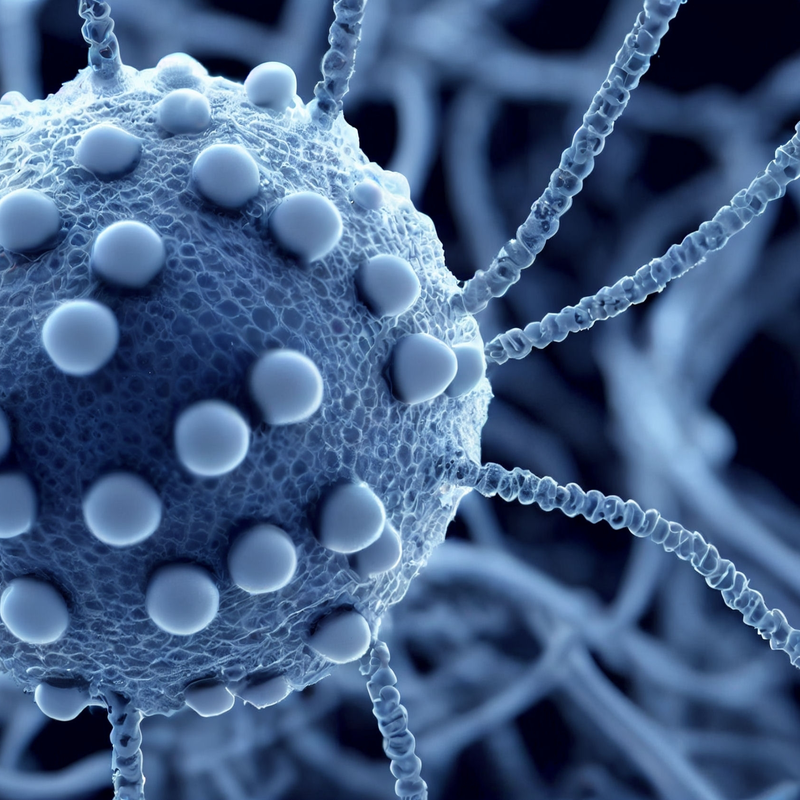
What are retroviruses?
Retroviruses are a widespread genus of RNA viruses in humans and vertebrates. During their replication, the single-stranded RNA of the genome is transcribed into double-stranded DNA in a process consisting of several steps. In the past, they were divided into three subfamilies. The Oncovirinae, Lentivirinae and the Spumavirinae. Today they are classified into seven genera. The 5 genera that contain RNA tumour viruses and can lead to various tumours, sarcomas or leukaemia in their hosts are:
- Alpharetrovirus,
- Betaretrovirus,
- Gammaretrovirus,
- Deltaretrovirus,
- Epsilon retroviruses.
What is the morphology of retroviruses?
Mainly there are retroviruses that have a single-stranded RNA. This is surrounded by the capsid, the protein coat. This structure is called nucleocapsid and, as with all other viruses, can be surrounded by a membrane or be free. Retroviruses, like all viruses, depend on a host to reproduce. They do not have their own metabolism and are therefore not considered living organisms.
Where do retroviruses occur?
Retroviruses are distributed worldwide and are not separated to specific locations. However, an international comparison shows that there are countries that are particularly affected by the viruses. Above all, retroviruses are found in areas and countries that have to cope with high numbers of HIV-infected people and AIDS patients. These regions can be considered a possible hotspot for the viruses, although this cannot be said with 100 percent certainty.
How dangerous are retroviruses?
Retroviruses were first researched as early as the 19th century. For a long time they were considered to be an exclusive causative agent of animal diseases. In animals, the diseases anaemia and the lung disease Jaagsiekte could be identified as the result of retroviruses. In today's time, it has been known for some time that retroviruses can trigger dangerous diseases not only in animals . Probably the best known of all diseases caused by retroviruses is HIV. As should be clear to everyone : There is no cure for HIV, although research has been going on for several years and decades. This should serve as a reminder to always remember how aggressive and resistant the retroviruses can be.
What diseases are caused by retroviruses?
Retroviruses are a known trigger for many different diseases. Therefore, the best-known ones are mentioned here.
Various tumours
Of course not every tumour has to be the product of a retrovirus. But it is quite possible that they enable the development of some cancerous tumours . Sarcomas and lymphomas are particularly common . Sarcomas are, was somewhat rarer, but should by no means be underestimated. Even if a sarcoma is detected and treated quite early , there is no certainty of successful therapy. Retroviruses are typical for their high mutation rate. The diseases caused progress rapidly and, especially in the case of sarcomas, metastasis occurs so, quickly. Especially via the bloodstream. In addition, most metastases often form so-called daughter tumours. This in turn makes therapy or even fighting the tumours almost impossible. Sarcomas mostly attack the muscle tissue and the connective tissue. For patients, this means severe pain and a tumour-related restriction of movement. This greatly reduces the quality of life of those affected.
Neurological diseases
Retroviruses can trigger a variety of different neurological diseases . Despite intensive medical research, many remain undetected. It can be said that not every person who becomes infected with retroviruses will suffer from a neurological disease. If there is a suspicion that any neurological diseases are connected to a retrovirus infection, elaborate tests must be carried out in order to be able to prove an actual connection .
Immunodeficiency
Probably the best-known disease caused by retroviruses is HIV, which after breaking out turns into AIDS. Although some very effective and well-tolerated drugs are now available on the pharmaceutical market , it is not curable.
What are the symptoms of retroviruses?
The symptoms vary depending on the disease that is triggered. These can range from general flu-like symptoms to swollen lymph nodes and very high fever. That is why it is not always easy to recognise an infection with retroviruses and is often dismissed by those affected as a simple flu infection. However, this is dangerous, especially for other people. The example of HIV shows how contagious the disease is, if you take the figures from Germany alone. In the Federal Republic of Germany, about 92,000 people are living with HIV, and the number of unreported cases is estimated to be much higher.
How are retroviruses diagnosed?
In order to be able to clearly explain the diagnostics, we will take the disease HIV as an example, which is triggered by retroviruses.
The diagnosis is made by detecting antibodies in the patient's blood. Two different blood values are checked to show the viral load in the body. In an HIV-positive patient, these values are tested at three-month intervals in order to be able to keep an eye on a change in the values.
How are retroviruses treated?
At a therapy against retroviruses, a specialised doctor should always be at the patient's side. As in the case of HIV, should be started with a suitable therapy as soon as possible after diagnosis. Antiretroviral agents are used here, which are best taken in combination of several of these agents . The aim is to stop the viruses from multiplying and thus prevent AIDS . As already described above, regular checks of the blood values are indispensable to see whether the therapy is working or not.
